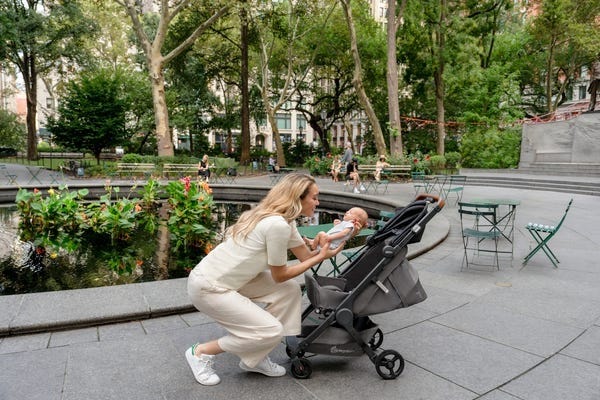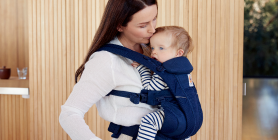
While some women never experience nipple pain when breastfeeding, for many new mothers nipple soreness in the first few days is very common. In fact, sore nipples are the number one reason most women give up on breastfeeding. It’s really a shameful statistic, since, for most women, the pain and tenderness is only temporary and usually lessens after a matter of days. In the first few days of breastfeeding, tender and sore nipples are to be expected. However, cracked and bleeding nipple conditions that last longer than a week should send a signal to new mothers that something more is going on, and it may be time to seek professional help. When a baby first latches on, there may be some level of pain. I always tell my clients to count to 30 and see if the pain level abates. If her pain doesn’t lessen up, it probably means they baby has not latched on or positioned properly. The solution is simple: try to take her off and latch her back on again. Your nipple should look the same coming out of the baby’s mouth as it did going in. If it’s looking like a new tube of lipstick, or if it is pinched with a line across it, it probably means your baby is not getting a proper latch to nurse. An improper latch can happen for many reasons. It can result from a myriad of scenarios such as a poor positioning of the baby at the breast, baby having tongue or lip ties, shallow latch (which means the nipple does not get to the back of the baby’s palate and instead is crushed against her gums), or other anatomical variations. Seeking help from a professional can help you determine the root cause of the issue. Finding and correcting the problem is the key to healing your sore nipples. Otherwise you risk re-damaging them each and every time you breastfeed. Degrees of soreness can vary from woman to woman, and solutions how to treat the pain also differ. Nursing from the less damaged side first can help provide some relief. Statistically, a baby tends to nurse more gently on the second side offered, as their hunger is less acute. Also, there are plenty of commercial salves and creams available to lessen pain. With all the products on the market, it can be hard to decide what will work best for you. The most common treatment for sore nipples is nipple cream that is designed help to soothe cracked and sore nipples. There are many available to choose ranging from lanolin-based (sheep wax) to plant-based products. Choose the one that fits best with your needs. Glycerin-based hydrogel pads are also very soothing. Gel pads help accelerate ‘moist wound healing’ by keeping the sore nipple from forming a hard scab. They can help speed up healing 50 percent faster than your body’s natural recovery. Breast shells, which you wear when you are not breastfeeding, can help to keep dampness away and clothing from sticking to the nipple. All of this helps, though you may need to try and experiment a little to see what works best for you. From my perspective, the best and most cost effective treatment for sore nipples is your own breastmilk. Freshly expressed breastmilk applied to your nipples not only soothes them, it also reduces the chances of infection. Remember, your human milk has antibacterial properties. A simple homemade saline solution is also very healing. Mix 1/2 teaspoon of salt in one cup of warm water. Make a fresh supply each day to avoid bacterial contamination. Soak nipples for a minute or two, then pat them dry with a clean towel. Applying expressed breastmilk after soaking helps to promote healing. If the pain is so bad that you feel afraid every time your baby is hungry, it is likely a good time to seek some help before you give up on breastfeeding altogether. I encourage you to give you and your baby a chance to learn how to breastfeed pain-free. Remember, you’re both new to this!
Emotional Benefits of Getting Outside
Spending time in nature with your baby can strengthen the bond between you. The simple act of holding your baby close, feeling their warmth, and sharing new experiences together can create strong emotional connections. It’s also a wonderful way to reduce stress and improve your mood. When my littles were extra fussy, I’d take a walk around the neighborhood. Even though I don't live in an area with trails and surrounded by nature, simply behind outside changed everything. A little vitamin D does wonders!
Cognitive Development
Nature is a sensory wonderland for babies. The different sights, sounds, and smells can stimulate your baby’s senses and promote cognitive development. Watching leaves rustle, hearing birds chirp, and feeling the texture of a tree bark can all contribute to their learning and development.
All About Baby Carriers for Nature Adventures
Choosing the Right Baby Carrier
When it comes to selecting the best baby carrier for summer adventures, there are several options to consider.
Types of Baby Carriers:
- Wraps: Perfect for newborns, providing a snug and secure fit.
- Slings: Ideal for quick and easy use, offering good ventilation.
- Soft Structured Carriers: Versatile and comfortable for both parent and baby, suitable for longer trips.
Factors to Consider:
- Baby’s Age and Weight: Ensure the carrier is appropriate for your baby’s size and weight. For example, Ergobaby’s Embrace Newborn Carrier is perfect for the fourth trimester where baby is small and you’re looking for an easy way to stay close. As they grow, you’ll want to upgrade to an all-position carrier that’s meant for growing babies.
- Parent’s Comfort and Ergonomics: Look for carriers with padded shoulder straps and lumbar support if you’re planning on longer outings.
- Ease of Use: Choose a carrier that is easy to put on and take off.
- Climate and Breathability: Opt for carriers made of breathable fabrics to keep you and your baby cool in hot weather.
Safety Tips:
- Proper Positioning: Ensure your baby is seated correctly, with their legs in an "M" position and their head should be close enough to kiss.
- Checking for Wear and Tear: Regularly inspect your carrier for any signs of damage.
- Ensuring Adequate Support: Make sure the carrier provides proper support for your baby’s head and neck.
Exploring Nature with a Baby Carrier
Ideal Spots for a Nature Walk with Baby
- Parks and Gardens: Great for leisurely walks and picnics.
- Nature Trails and Forests: Perfect for more adventurous outings.
- Beaches and Lakesides: Wonderful for enjoying the water and sand, with the right carrier.
Activity Ideas
- Hiking: Enjoy a scenic hike with a hiking baby carrier that offers support and storage.
- Bird Watching: Use your carrier to keep your baby close while you explore and observe wildlife.
- Picnics: A carrier can free up your hands, making it easier to carry picnic supplies.


Advantages of Using Strollers for Nature Adventures


While baby carriers are fantastic for mobility and closeness, depending on the adventure of choice you might want to be a stroller along too.
There are a LOT of baby stroller options on the market. So we understand how confusing it can be to choose the one that’s right for your family. Not only are there a variety of brands, but a variety of strollers that serve different purposes.
There are a few types of strollers on the market:
- Full-sized stroller: This is typically the stroller parents thing of buying for all its versatility.
- Lightweight or umbrella stroller:These compact strollers are perfect for on-the-go adventures.
- Jogging stroller: Designed for parents who want to combine fitness with outdoor adventures.
- Double stroller: Designed for parents with multiple kids, especially twins.
- Car seat carrier: These strollers connect to a specific car seat. We don't typically recommend these as they can be unsafe for baby and uncomfortable for parents who are pushing.
Learn more about the types of strollers and which one would be best for you.
Benefits of Bringing a Stroller
- Storage Space for Gear: Ample room for carrying all your essentials like a diaper bag, beach toys and more.
- Shade and Weather Protection: Built-in canopies to shield your baby from the sun when they are lounging.
- Options: If you have more than one kid, you can stroll with one and carry the other. Or, if you’re getting warm or your little one is getting fussy, you can switch up their position from stroller to carrier or vice versa.
Safety Tips for Strollers
- Ensure your stroller is in good working condition. Make sure buckles are still buckling and that there are no rips or holes that could compromise your baby’s safety.
- Use sunshades or bug nets to protect your little one’s skin.
- Securing the baby properly: always buckle up your baby for safety even if you think they are old enough to go without the buckle.
Combining Baby Carriers and Strollers
For the ultimate flexibility, consider using both a baby carrier and a stroller on your outings.
Combining both options allows you to adapt to different situations. Use the carrier for more rugged trails and switch to the stroller for smoother paths or when your baby needs a nap.
Transition Tips
- Smooth Transitions: Plan stops where you can easily switch from carrier to stroller.
- Pack Light: Only bring essentials to make transitions easier.
Tips for a Successful Adventure
Planning Ahead
- Route Planning: Choose baby-friendly trails and parks. Check local mom groups or outdoor groups and get recommendations for the best outings for kids.
- Check Weather Conditions: Avoid extreme heat or unpredictable weather. Even with our most breathable carriers, when it’s hot, it’s hot. And having two bodies against each other in the heat will be naturally hot and sticky already.
- Packing Checklist: Include diapers, snacks, water, sunscreen, and a first-aid kit. These all-position carriers have storage pockets where you can fit some of the items easily!
- Stay Hydrated and Nourished: Pack healthy snacks to keep energy levels up and bring plenty of water for both you and baby.


Summer adventures with your baby are a wonderful way to create lasting memories and enjoy the beauty of nature together. From baby carriers to strollers, Ergobaby products are designed to provide comfort and ease for both you and your little one. So, gear up, get outside, and explore the world with your baby by your side.
Ready to embark on your own summer adventures? Check out Ergobaby’s range of baby carriers and strollers to find the perfect match for your family’s needs. Visit our website today and start planning your next outdoor excursion!
























